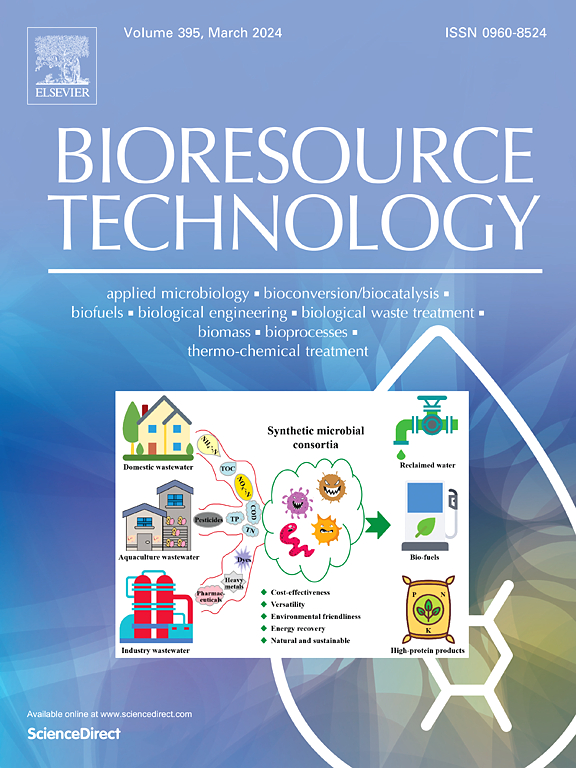pH-adaptive evolution of glutamate decarboxylase enables gamma-aminobutyric acid biosynthesis without pH control
IF 9
1区 环境科学与生态学
Q1 AGRICULTURAL ENGINEERING
引用次数: 0
Abstract
The strict pH-dependent catalytic activity of glutamate decarboxylase (GAD) necessitates substantial acid consumption during γ-aminobutyric acid (GABA) biosynthesis, increasing costs and environmental impact. To overcome this limitation, we engineered glutamate decarboxylase from Escherichia coli (EcGadB) for enhanced activity at neutral pH. Using constant pH molecular dynamics (CpHMD) simulations, we targeted the pH-sensitive γ-carboxyl-binding loop (γ-CBL). Through three rounds of Adaptive Iterative Evolution (AIE) guided by a GABA biosensor, mutant M3 (Y51L/A56P/D68N/D69T) was obtained, which exhibited a 43.5-fold enhancement in catalytic efficiency (kcat/Km) at pH 7.5. Gaussian-accelerated MD simulations indicated that M3 stabilizes catalytic conformations of γ-CBL, decoupling its activity from acidic conditions. By further design, mutant M4 (M3-Q348D/M431K) with significantly improved thermostability was obtained. M4 was applied to three pH-control-free catalytic systems: achieving 360 g/L GABA in enzymatic catalysis (50 °C, 8 h), 219 g/L in whole-cell biocatalysis, and 60 g/L (1.71 g/L/h space–time yield) in high-cell-density fermentation. This study establishes an integrated computational/directed evolution loop engineering paradigm, enabling efficient, sustainable, and economically viable enzymatic GABA production by eliminating pH control requirements and enhancing process robustness.
谷氨酸脱羧酶的pH适应性进化使γ -氨基丁酸的生物合成无需pH控制。
谷氨酸脱羧酶(GAD)的催化活性严格依赖于ph值,因此在γ-氨基丁酸(GABA)生物合成过程中需要消耗大量的酸,增加了成本和环境影响。为了克服这一限制,我们设计了大肠杆菌谷氨酸脱羧酶(EcGadB),以增强其在中性pH下的活性。利用恒定pH分子动力学(CpHMD)模拟,我们瞄准了pH敏感的γ-羧基结合环(γ-CBL)。在GABA生物传感器的引导下,通过3轮自适应迭代进化(AIE)得到突变体M3 (Y51L/A56P/D68N/D69T),在pH为7.5时,其催化效率(kcat/Km)提高了43.5倍。高斯加速MD模拟表明,M3稳定了γ-CBL的催化构象,使其活性与酸性条件解耦。通过进一步设计,获得了热稳定性显著提高的突变体M4 (M3-Q348D/M431K)。M4应用于三种无ph控制的催化体系:酶催化(50 °C, 8 h)达到360 g/L GABA,全细胞生物催化达到219 g/L,高密度发酵达到60 g/L(1.71 g/L/h时空产率)。本研究建立了一个集成的计算/定向进化循环工程范例,通过消除pH控制要求和增强过程鲁棒性,实现高效、可持续和经济可行的酶促GABA生产。
本文章由计算机程序翻译,如有差异,请以英文原文为准。
求助全文
约1分钟内获得全文
求助全文
来源期刊

Bioresource Technology
工程技术-能源与燃料
CiteScore
20.80
自引率
19.30%
发文量
2013
审稿时长
12 days
期刊介绍:
Bioresource Technology publishes original articles, review articles, case studies, and short communications covering the fundamentals, applications, and management of bioresource technology. The journal seeks to advance and disseminate knowledge across various areas related to biomass, biological waste treatment, bioenergy, biotransformations, bioresource systems analysis, and associated conversion or production technologies.
Topics include:
• Biofuels: liquid and gaseous biofuels production, modeling and economics
• Bioprocesses and bioproducts: biocatalysis and fermentations
• Biomass and feedstocks utilization: bioconversion of agro-industrial residues
• Environmental protection: biological waste treatment
• Thermochemical conversion of biomass: combustion, pyrolysis, gasification, catalysis.
 求助内容:
求助内容: 应助结果提醒方式:
应助结果提醒方式:


